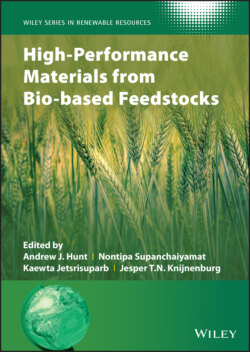Читать книгу High-Performance Materials from Bio-based Feedstocks - Группа авторов - Страница 58
3.2.2.1.2 Characterisation of Sulphonated Material
ОглавлениеSulphonated Starbon has been analysed thoroughly in terms of porosity, elemental composition, and SO3H loading: all characteristics affecting the validity of these materials as solid acid catalysts. In the original publication, the SO3H loading on Starbon‐400 was reported as 0.5 mmol g−1 as determined by thermogravimetry coupled to infrared spectroscopy (thermogravimetry‐infra red [TGIR]) [17]. Further investigation showed that the loading remained in this region for preparation temperatures of 600 °C and below. Starbon‐650 and above resulted in a lower concentration of active acid sites (0.3–0.4 mmol g−1) [18, 21]. This was further corroborated by pyridine absorption experiments showing that the acidity of sulphonated Starbon did not change considerably with preparation temperatures of 600 °C or less. However, stronger Lewis acidity was observed at lower temperatures [18, 19]. Later, Aldana‐Pérez et al. reported a –SO3H content of 1.2, 1.8, and 2.3 mmol g−1, and a total number of acid sites as 8.0, 8.2, and 10 mmol g−1, respectively, for Starbon‐300 sulphonated by H2SO4 for 15 hours, a mixture of 2 : 10 ClSO3H/H2SO4 for five hours, and a mixture of 3 : 10 ClSO3H/H2SO4 for five hours [20]. In this case, acidity was measured by potentiometric titration.
Transmission electron microscopy (s) and scanning electron microscopy (SEM) imaging of Starbon have shown that sulphonation did not considerably change the particle size or morphology of the material, which is amorphous after functionalisation, but the structure was prone to cracking at higher carbonisation temperatures as is true for the unsulphonated Starbon [18]. Starbon‐400 was shown to remain predominantly mesoporous (pore size 5–15 nm) after sulphonation, although the mean pore diameter and surface area decreased. As with the original Starbon, microporosity increased with preparation temperatures above 500 °C [19, 21]. A homogeneous distribution of elements was also observed [20]. Additional N2 adsorption studies showed that the average pore diameter of sulphonated Starbon was 8–12 nm [21]. Sulphonated Starbon‐400 had a Brunauer‐Emmett‐Teller (BET) surface area of 386 m2 g−1 and pore volume of 0.62 cm3 g−1. Aldana‐Pérez et al. reported a decrease in BET surface area on sulphonation from 163 m2 g−1 for Starbon‐300 to 66, 75, and 77 m2 g−1, respectively, for Starbon‐300 sulphonated by H2SO4 for 15 hours, a mixture of 2 : 10 ClSO3H/H2SO4 for five hours, and a mixture of 3 : 10 ClSO3H/H2SO4 for five hours [20].
Diffuse reflectance infra red (DRIFT IR) analysis of the original sulphonated Starbon‐400 showed little change in surface structures before and after sulphonation [18, 21]. Peaks in the region of 1300–600 cm−1 were attributed to –SO3H groups confirming the incorporation of sulphur into the Starbon structure, although differentiation between O–SO3H and C–SO3H was not possible. Aldana‐Pérez et al. performed fourier Transform infra red (FTIRP) photoacoustic spectra – an infrared technique particularly well suited to study dark samples – of the sulphonated and presulphonation Starbon, as shown in Table 3.1 [20]. In particular, this confirmed the presence of –SO3 groups in the sulphonated Starbon by the appearance of the S=O band at approximately 1040 cm−1. Additionally, there is a reduction in the CH2/CH3 signal at approximately 3000 cm−1, which was attributed to oxidation of aliphatic carbons to carboxylic acids, although oxidation to ketones should also not be excluded in Starbon‐300, where significant carbohydrate character (in particular –CH(OH)– groups) should remain.
Table 3.1 Summarised IR data of a range of sulphonated and unsulphonated Starbon.
Source: From Aldana‐Pérez et al. [20].
| Wavenumber (cm−1) | Vibration | Appearance |
|---|---|---|
| 1040 | S=O symmetric stretch | Sulphonated |
| 1610 | Aromatic C=C stretch | Both |
| 1719 | C=O stretch | Both |
| 3000 | CH2/CH3 | Unsulphonated |
| 3440 | C(O)OH/PhOH stretch | Both |
Solid and liquid 13C NMR data were also collected for the sulphonated catalyst, Starbons‐300‐2–H2SO4–ClSO3H–TEPO, using triethylphosphine oxide (TEPO) as a probe molecule to find the relative acid strength [20]. This was done by dissolving 0.05 g of material in 5 ml of 1 M TEPO in hexane, stirring for one hour, followed by drying at 40 °C under vacuum. The resulting solid was dissolved in deuterated chloroform. Having managed to get better resolution of signals in the liquid state, bands at 128.94, 131.05, and 132.54 ppm were assigned to aromatic carbons while band 167.94 ppm was assigned to carboxylic carbons. The 31P MAS NMR (magic angle spinning nuclear magnetic resonance) of the same material showed the shift of a signal from 53.89 ppm in the unsulphonated Starbon to 85.30 ppm in the sulphonated material, which was attributed to the change from hydroxyl to sulphonic groups, whose interaction with TEPO confirmed strong Brønsted acid character.
Elemental analysis of the original sulphonated Starbon gave a sulphur content of 1.9% (Starbon‐400‐SO3H), 1.4% (Starbon‐650‐SO3H), and 1.3% (Starbon‐750‐SO3H) [21], whereas Aldana‐Pérez et al. reported a higher sulphur content of 3.30% by X‐ray photoelectron spectroscopy (XPS), possibly due to the much longer duration of sulphonation in their method [20].
